Catechesis of the Good Shepherd: our home atrium

Want to learn how to introduce Catechesis of the Good Shepherd to your kids at home?
My background
Over the past year I’ve shared about our family’s home atrium on Instagram (part 1 and part 2) and in my Holy Labor newsletter (here).
After I completed Level I training in the Catechesis of the Good Shepherd (CGS), I felt drawn to offer a version of this Montessori-based method of faith formation to my own children—as I hope to help start an atrium in our parish one day, too.
Turns out the pandemic brought me that unexpected opportunity as our kids were home all the time! Over the past two years, I’ve been introducing our kids to the beauty of CGS, making materials, and learning about the joys (and challenges) of being a catechist for one’s own children.
Readers have asked me to share about our experience of building a home atrium, so I wanted to compile this collection of ideas and resources that might help others.
A note before we begin
First, CGS is intended to be offered in community, not primarily in the home setting. Any materials I made were created in the hopes of sharing them with others in the future. It’s impossible to recreate the full atrium experience at home due to limitations of space, materials, and most importantly, the gift of a diverse group of children in community.
A home atrium is not ideal—but as we are all learning to live in liminal space right now, I’ve followed my formation leader’s wisdom of not letting the perfect get in the way of the good. I’ve been grateful for what I have been able to share with my children at home.
Second, my children attend a public Montessori school, so they were able to enter easily into the space and “feel” of an atrium. They are familiar with the Montessori way of life, the presentation style, practical life, working with materials etc. I imagine that this could take more time with children who have not experienced a Montessori environment before.
Third, I could not have done all this without the two years of training I completed. I would strongly encourage anyone who is interested in learning about CGS to consider taking a formation course. The training is a commitment of time and energy, but it is life-changing.
That said, I know this opportunity to do formation is not available to everyone, for a variety of reasons. In the spirit of sharing the gift that has changed my life, I hope the “beginner” ideas and resources might be helpful for anyone who is just starting to learn about CGS.
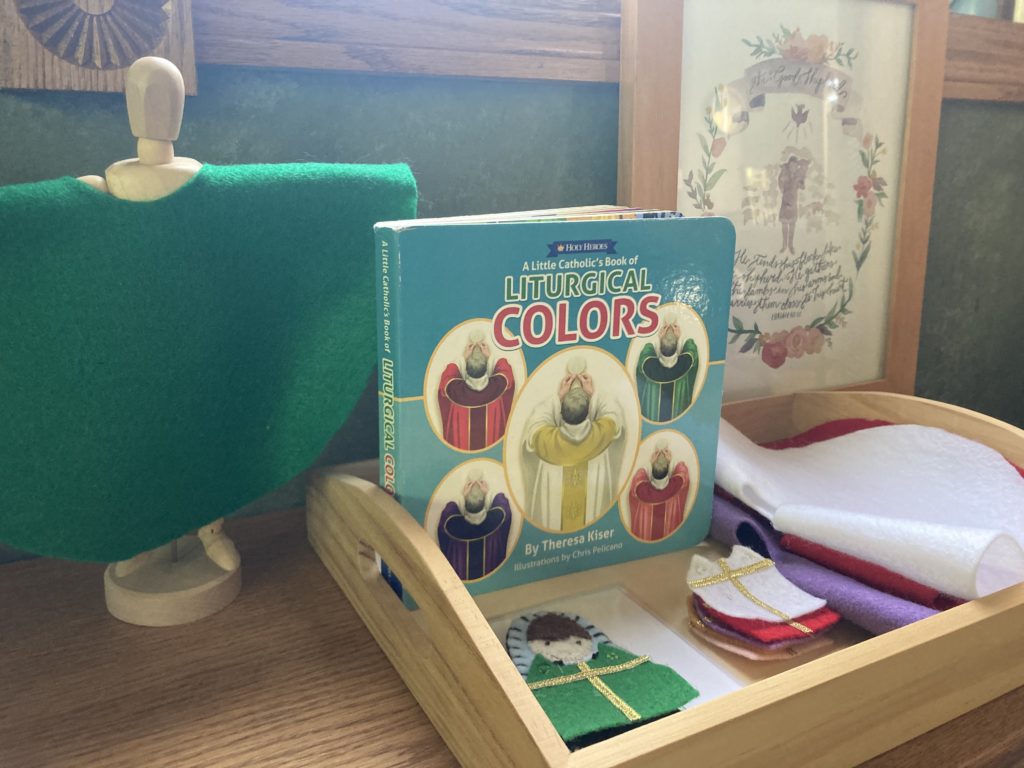
If you are brand-new to Catechesis of the Good Shepherd
Welcome! If you’re interested in learning more, start with the CGS-USA website for a great introduction. Let yourself linger with this beautiful video reflection that offers an overview of CGS, too.
The atrium is the sacred space prepared for young children to spend time listening to God and enjoying the gifts of faith prepared for them. Developed by Sofia Cavalletti (a Hebrew and Scripture scholar) and Gianna Gobbi (a Montessori educator), CGS is an ecumenical approach to Christian formation, grounded in Scripture and liturgy, and centered on the relationship between the child and God.
Catechesis of the Good Shepherd is offered primarily in the local church setting. You can search for an atrium near you using these links to find an atrium in the U.S. or in Canada, for example.
If you want to learn more, The Good Shepherd & The Child podcast is a wonderful resource with many episodes on Scripture, spirituality, and the joys of listening to God with children.
Starting a prayer corner in your home can bring the heart of CGS to your family. All you need is a quiet corner, a small shelf or table, and a few simple, beautiful items to invite your child to prayer:
- Cross or crucifix (CGS suggests the San Damiano crucifix)
- Candle (like this simple votive candle)
- Bible (set on a stand if possible)
- Small Good Shepherd statue or icon (we have a mini hand-painted wooden figure from In The Loft – Sue Dow)
- Liturgical cloths to match the colors of the liturgical seasons (small reversible options here)
- Prayer cards with phrases or verses from Scripture/liturgy or a small basket with religious images (e.g., holy cards, Christmas cards, or religious pictures found online)
- With older children, you could add a candle snuffer to help extinguish the candle. We also have a tiny globe that the older kids like to hold when we offer petitions.
Catechesis of the Good Shepherd is grounded in Scripture and liturgy. Think about simple ways to read Scripture together as a family or celebrate the liturgical year together. Creating prayer cards with liturgical colors and choosing a simple verse or short story from Scripture to read together can be a beautiful and easy way to pray as a family.
A fellow catechist generously shared this guide to help you get started on your own prayer corner (thank you, Kate!).
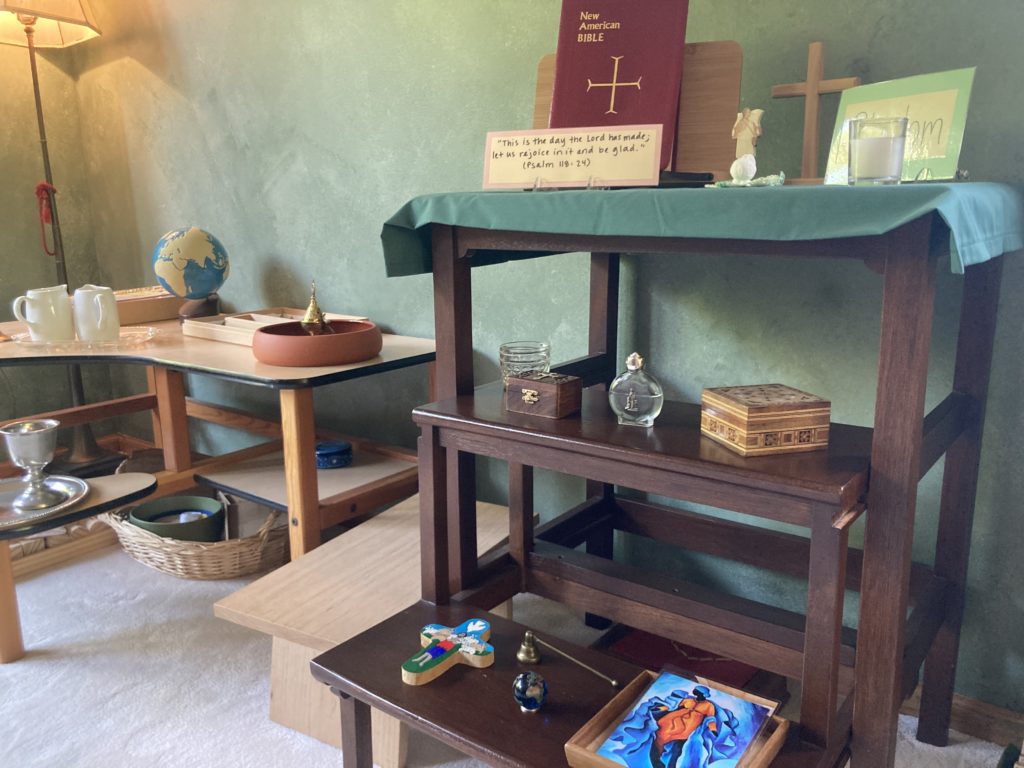
If your child has experience in an atrium & you want more resources
Check out the resources for parents from CGSUSA, in particular the Parent Pages that accompany the liturgical seasons, themes, and materials of the atrium.
These two books offer excellent overviews of CGS for parents and catechists, with explanations of the various works and presentations the child will encounter in the atrium:
- The Good Shepherd and the Child: A Joyful Journey for ages 3-6 (be sure to get the revised & updated version) as a companion to The Religious Potential of the Child: Experiencing Scripture and Liturgy with Young Children
- Life in the Vine: The Joyful Journey Continues (for ages 6-12) – a practical and accessible companion to The Religious Potential of the Child: 6-12 years old
A few books I love for children, at home or in church:
- Overview of CGS: A is for Altar, B is for Bible
- Liturgy: A Little Catholic’s Book of Liturgical Colors and Light of Sunday
- Scripture: I found a great deal on a used Little Gospels, but my kids actually prefer our handmade Scripture booklets. Found: Psalm 23 is a beautiful book on the Good Shepherd, but better to wait until children discover who the sheep are before enjoying together.
We had a small prayer corner before I started CGS training, and then we added a Wooden Mass set from Almond Rod Toys to create a model altar at our prayer corner:
I also found free religious Montessori printables online that we could use for simple presentations (like this set of free altar cards from Teachers Pay Teachers).

If you are trained in CGS & want to start a home atrium
Mustard Seed Training has a helpful post on how to start an atrium: first you form the adult (that’s you!); next you prepare the environment; and then you welcome the child.
Here’s how I did it:
- Space: I turned an area of our living room (which was also used partly for Montessori homeschool) into our atrium. Since a home atrium is limited in space, I rotated materials by liturgical season onto several low bookshelves (built by my handy husband!).
- Time: What worked best was to do our “Good Shepherd time” on Sunday afternoons/evenings and any other time of the week that the children asked to do it, usually in the evenings as part of our family prayer.
- Preparation: This is the area where I feel the need to put more energy in the coming year, to the prayerful preparation of the adult as the catechist (me!). Less worrying about the materials, more time spent in prayer and preparation with my formation album.
- Children: Our kids currently age from 1-12, so we have many different planes of development following Maria Montessori’s wisdom! I am fully trained in Level I (ages 3-6) and partly trained in Level II (ages 6-9) so I primarily worked with our two kids in this age range. I adapted other materials for the older two kids, and I’m learning about the idea of a toddler atrium for our youngest.
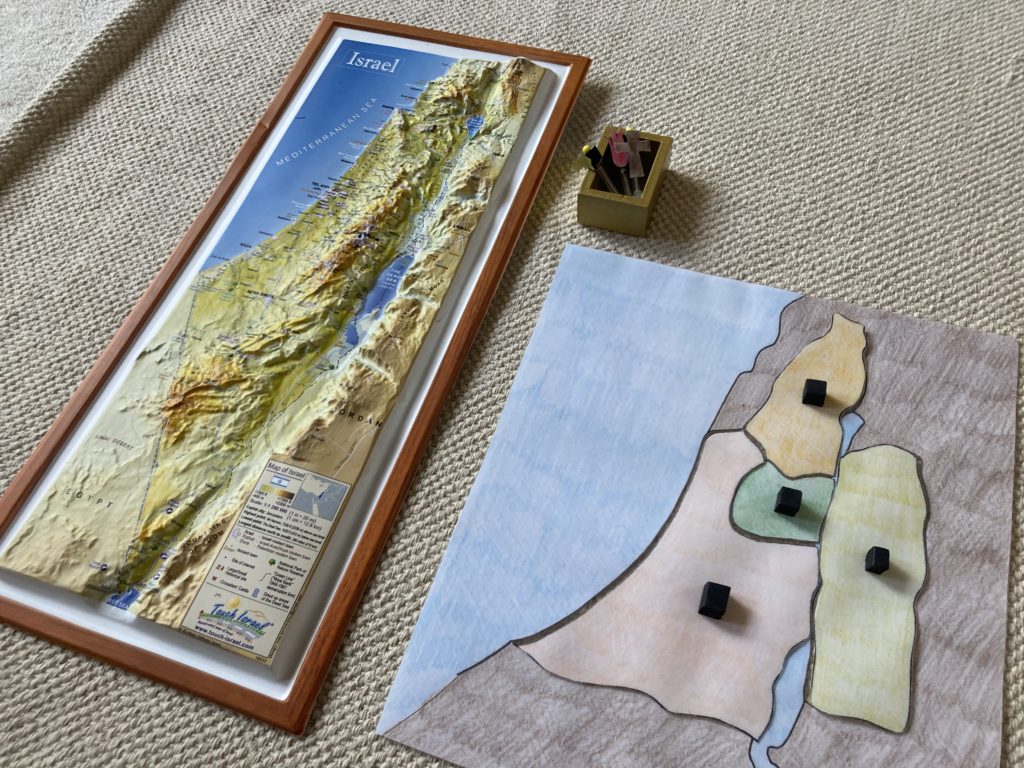
Catechesis of the Good Shepherd materials
There are many beautiful shops for atrium materials, but I found that the price and size of full atrium materials were often too much for our home atrium.
I found many materials at local thrift stores: wooden trays/wicker baskets, pewter wine cups for chalices, plates for paten and ciborium, a red candle holder for the sanctuary lamp, placemats for altar cloths, etc. I also found free bookshelves, trays, and storage boxes from our local “Buy Nothing” Facebook group, too. There are plenty of affordable ways to build an atrium!
We already had Montessori works in our homeschool area to use for practical life (e.g., a small knobbed cylinder set, spooning and pouring works, and simple puzzles). The children use their Montessori floor mats for our atrium as well.
Making materials is an important part of the catechist’s preparation. I’m not a crafty person by nature, but I’ve come to appreciate the spiritual practice of material making with the help of the materials manuals available to CGS members. The simpler, the better: paper and cardboard can work just fine for a home atrium when less children will be handling materials, too.
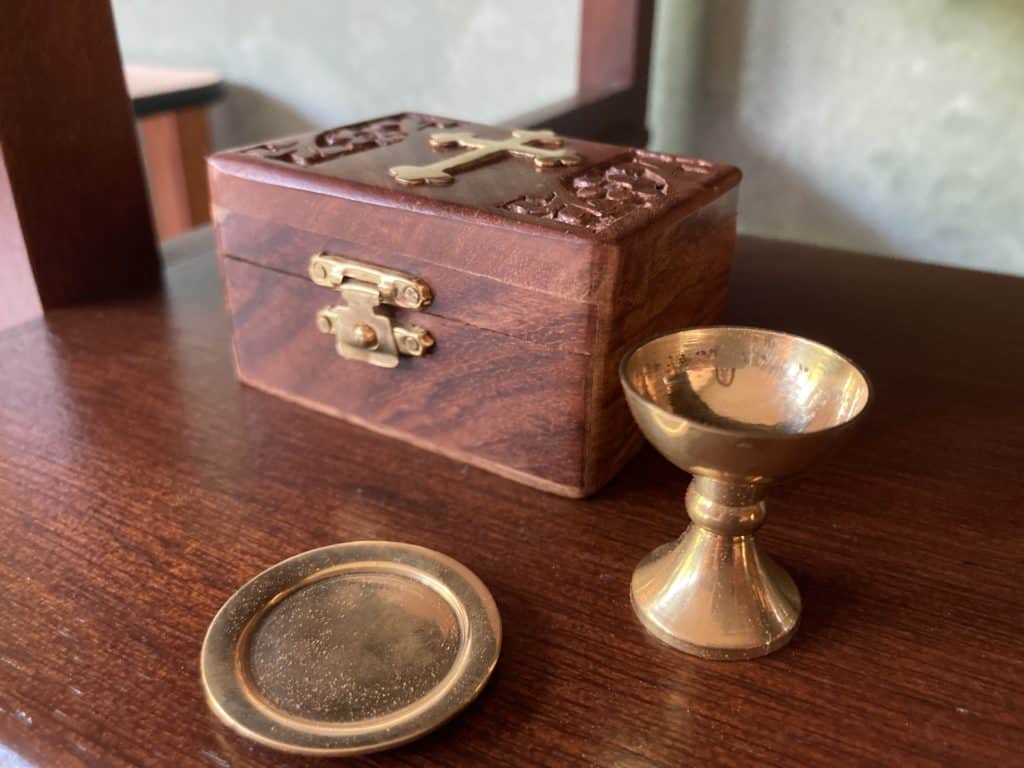
Sources & resources for Catechesis of the Good Shepherd
Over time I’ve bought or made materials from online shops, too. I try to buy directly from CGSUSA to support their mission, but I also found materials from small businesses like Etsy shops—and lots of DIY inspiration from Pinterest if you’d like to check out my board of ideas for children and catechesis.
Please note: many of the shops linked below offer small selections or custom items, so particular items may not always be in stock. Contact shop owners directly for more details.
- Good Shepherd & sheep and parable figures from The Sheep Gate
- Peg dolls in diverse skin/hair colors from My Sunshine Designs
- Annunciation figures from Treasured Saint Dolls
- A Nativity set from Oh Golly My Dolly
- Figures to use for the Empty Tomb & the Eucharistic Presence of the Good Shepherd from Annalisa Boyd
- Resurrection set from Smith Shenanigans
- Paschal candle sticker from Liturgical Living Box
- I got creative with clearance figures from Rainbow Peg Dolls (since I love their Holy Family set)
- We built the City of Jerusalem from this block set and inspiration from Catholic Icing
I have not tried these resources, but I know other families have loved them:
- Cut-and-go chasubles from BettyJoSews (she also offers liturgical prayer cloths and a full set for sewing atrium materials)
- A small wooden Good Shepherd set to paint
- Printable sheepfold or backdrops for the infancy narratives from MajellaStore
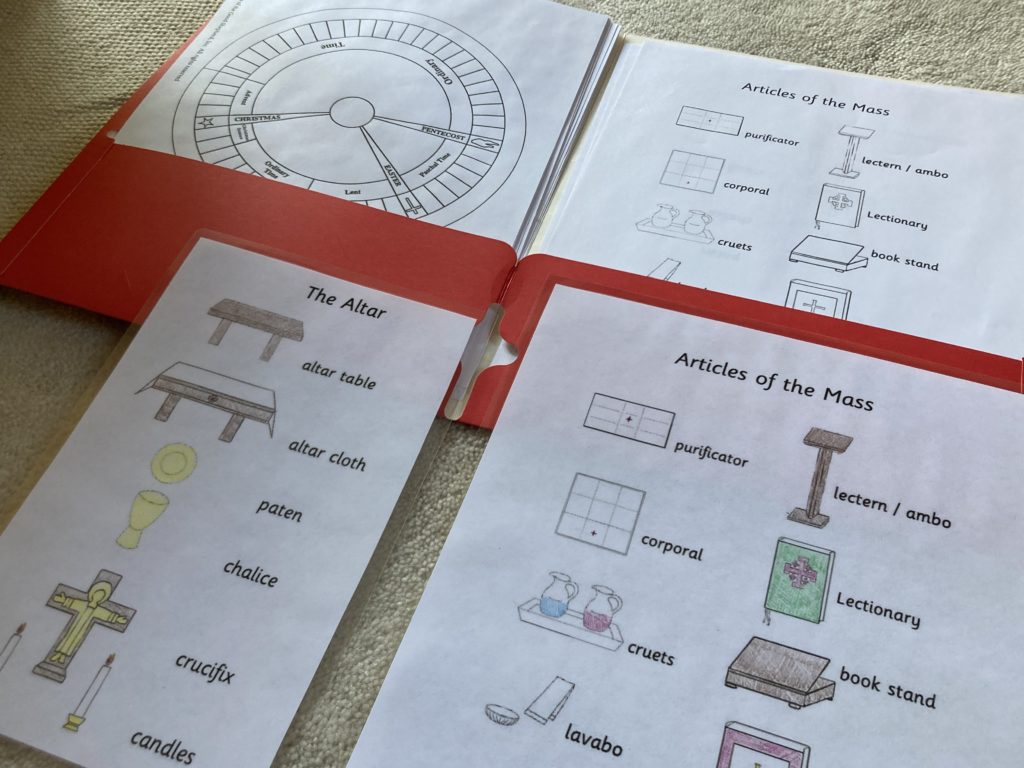
Looking back
Overall our ongoing experience of having a home atrium has been joyful and peaceful. Lots of learning and pondering. Far from perfect, but full of grace.
When I asked our kids what they loved most this year, they told me:
- geography works: sandpaper globe and map of Israel; the city of Jerusalem
- liturgy works: the model altar; chasubles; liturgical calendar
- processions (“beautiful walking”) to change the prayer corner for a new liturgical season
- prayer time: choosing prayer cards, reading Scripture, and lighting candles (of course!)
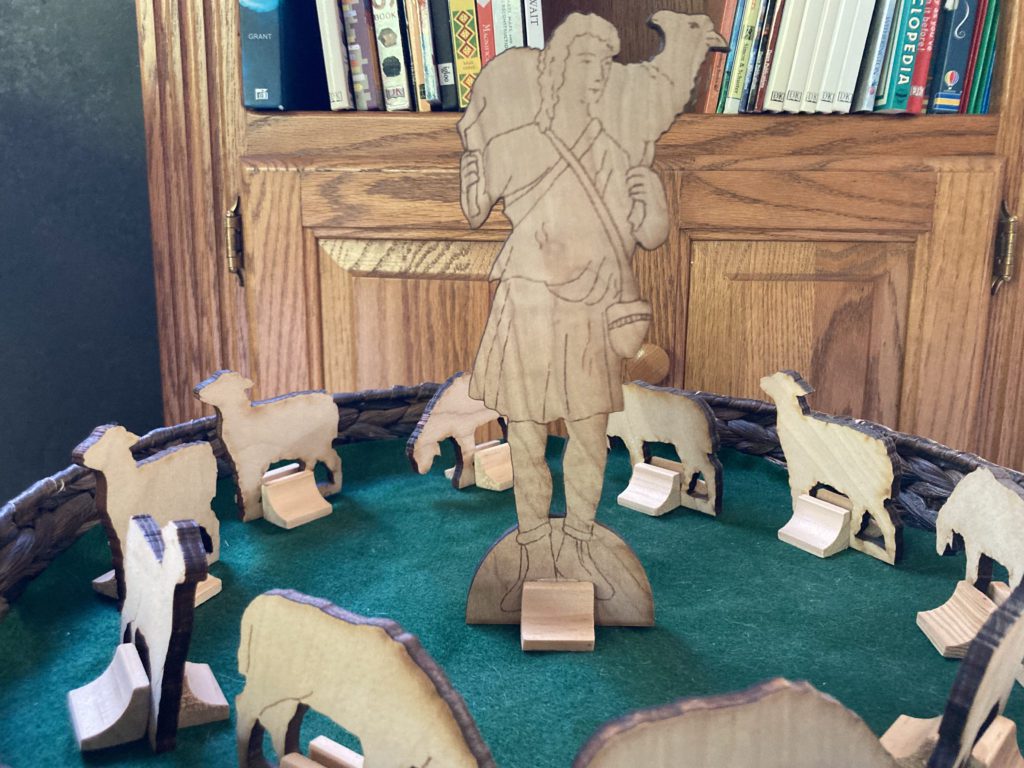
Have you used Catechesis of the Good Shepherd at home? I’d love to hear from you! Please share your experience or recommended resources below.
This post contains affiliate links as I am a member of the Amazon Affiliate program and Etsy’s affiliate program.

Holy Spirit, you who makes me see everything and shows me the way to reach my ideal, you who gives me the divine gift to forgive and forget all the wrong that is done to me and you who are in all instances of my life with me. I, in this short dialogue, want to thank you for everything, and affirm once more that I never want to be separated from you no matter how great the material desires may be. I want to be with you and my loved ones in your perpetual glory. To that end and submitting to God’s holy will, I ask from you..(mention your favour). Amen
This prayer should be said for 3 consecutive days. After the 3rd day, your sincere wish will be granted no matter how difficult it may be. Promise to offer thanksgiving by sharing it and expressing it on granting of your favour. The idea is to spread the wonder of the Holy Spirit.
I’m in tears browsing this article as my heart fell in love with CGS about 20+ years ago when I had the gift of doing catechesis level 1 training. I never was able to have an atrium to teach in, but this method truly changed me and my parenting. Read some of the books at a minimum, they are powerful!
I was just thinking about how you had mentioned your home atrium on IG and was wondering how it was going! Thank you for the update and all these wonderful resources!
Laura, you have done an amazing job building this home atrium! I have been a CGS catechist for 11 years. I take some works on the road for my grandchildren, and work in several schools, but do not actually have a home atrium, although I have lots of stuff. If anyone around the Flint/Flushing Michigan area needs help with supplies, or with anything else feel free to contact me.
This is a beautiful guide, Laura!
Thanks for sharing these resources!
CGS has had a profound impact on my life. I am so thankful I’m able to listen to God together with children in the Atrium at my church.